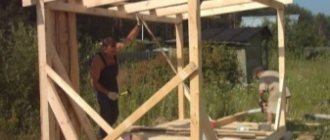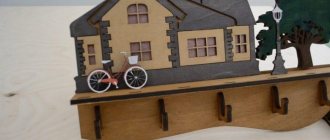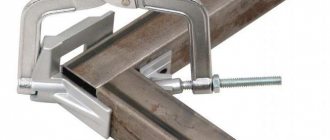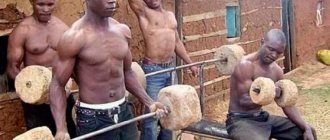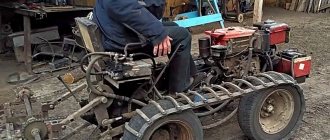When working in a home workshop, it’s rare that everything goes off without a hitch. Either you can’t unscrew the screw, or the necessary tool has disappeared somewhere.
In general, you constantly have to face various difficulties.
In today’s article we want to share with you carpentry tricks that will be useful to a novice craftsman (and a professional too) and will help you cope with certain difficulties. Let's look at 5 situations where our tips can be applied.
Duct tape, sneakers and drawers
If you are assembling or disassembling any mechanism from small parts, it will be convenient to stick double-sided adhesive tape on the table so that you can place the parts on its surface. They won't get lost by sticking. If you need to climb a ladder without scratching the surface of the wall, you should tape clean-soled sneakers to the ends of the ladder before installing it.
You can also make useful homemade products and devices with your own hands if you have a full-fledged staircase in your house to the second floor. Under each step you can make drawers where you can put household items. Some of the steps can be made folding by securing them on hinges. This way you can use their interior space as jewelry boxes.
Can't unscrew the screw
It happens that the slots on the screw head are ground off, and it is not possible to unscrew the screw using the standard method.
Well, let's act outside the box.
We glue a piece of PVC electrical tape onto the head of the self-tapping screw (preferably in 2 layers). We try to unscrew it - everything works. And there is no need for any dancing with tambourines.
Plastic windows, screwdriver and metal corner
It is difficult today to find an apartment or house where plastic windows are not installed. If your home has such double-glazed windows, they have seals. If you don't want them to crumble, you can extend their service life. To do this, spray silicone lubricant should be applied to the seals once a year.
Considering the little tricks for the home handyman, you can note the following for yourself. If you don't have a screwdriver handy for small screws, you can quickly make one by sharpening the tip of an old can key. If you want to update the interior and hang a heavy picture, then it will need to be supported from below. This can be done by attaching a metal corner to the wall.
Mirrors, holes in walls and small screws
If you attach a mirror above the top shelf of your wardrobe, then you won’t have to climb onto a platform to see what’s stored there.
When you have to drill holes in walls where there is hidden wiring, there is a risk of getting the drill into communications. You can find the wiring in the wall using a tape recorder. To do this, an electrodynamic microphone is connected to it. The device should be turned on for recording at maximum gain. When the microphone is placed along the wall, a low hum will be heard from the speakers of the tape recorder in the places where the wiring is laid. As the device moves away from the wiring, the hum will begin to weaken. It is safest to drill in the place where the hum completely disappears.
Little tricks for the home craftsman can be useful and unusual. For example, in order to hammer a nail, it should be inserted between the teeth of a comb. This way you will save your fingers. A special holder for screws and nails can also be made from a regular wooden clothespin.
The diameter of the hole is larger than the diameter of the screw
Here's another unusual situation.
For example, you need to screw a self-tapping screw into a hole that has already been drilled earlier. But it is larger than the diameter of the screw, and the fasteners simply dangle in it.
Here an ordinary match will come to our aid. We insert a match into the hole, break off the excess, and then calmly screw in the self-tapping screw.
If you approach the problem more carefully, then instead of a match it is better to make a wooden chopstick and drive it tightly into the hole. It will be more reliable this way.
Vernier calipers, holes and shelves of complex configuration
A plastic or metal safety bracket must be secured over the caliper locking screw. To do this, you need to drill two holes in the meter engine and then cut the thread. After these manipulations, the screw cannot be lost.
In order to obtain a hole of the required depth, you can apply paint marks to the drill. Sometimes insulating tape is used for this purpose, which is glued in several layers. But during operation, such marks may become lost. It is most reliable to put washers of a suitable diameter on the drill. This template is convenient because it can be taken out and adjusted by adding or removing washers.
Little tricks for the DIYer can make his life easier. For example, if you want to make a shelf with a complex configuration and install it in a built-in closet, you can prepare a template for this from strips of cardboard. It is much easier to adjust the product to size.
Small nails, float and release valve
Using a wooden ruler with a small magnet glued to it, you can make a handy tool for driving small nails.
If necessary, you can replace a failed tank float using a syringe of the required volume. If the toilet flush valve begins to leak, you can stop the leak using a weight. The rubber bulb, under the influence of additional weight, will fit into the saddle more tightly, and the leakage will stop.
Self-tapping screw splits wood
Yes, this happens quite often.
Especially in cases where the self-tapping screw is screwed into the very edge of the workpiece, a crack appears not only at the top, but also at the end. This is no good.
So what's the problem? Step back and screw in calmly. That’s how it is, but sometimes you need to screw the screw into the edge of the workpiece.
In this case, there is a simple solution: use pliers to bite off the sharp tip of the self-tapping screw and screw it into the workpiece. There will be no cracks!
Removing clogs, cutting tapes and flattening nails
Little tricks for the home handyman can sometimes help you avoid unnecessary expenses. For example, if there is a blockage in the drain, the drain pipe in the bathtub or sink can be vigorously pumped using a car or bicycle pump to which a flexible rubber tube must be connected.
By taking 2 blades, which should be fixed on a wooden block, you can cut ribbons of a certain width. The material used can be polyethylene, paper or leather.
When you need to drive nails into wood, you can simplify the process by flattening them. Woodworkers often do this with a point. To do this, it is hit with a hammer. If the nail is flattened, it will go into the wood and will be held there by the springiness of the broken fibers. When a nail is sharp, it can split wood.
Secrets of carpentry
In my publications, I try to touch on topics that for the average person (a person far from carpentry) are sealed secrets. I hope that this time I will be able to open Pandora’s box for my readers too. So, I would like to touch on the topic of interior design, or rather wood products that are interior parts, as well as their durability. In the concept of interior details, I include, of course, furniture, as well as finishing panels, cornices, facades, doors and other large objects.
I'll start from afar. In the Contract for the production of wood products, I always include the clause “The Contractor is not responsible for the natural deformation of the wood.” Where did this wording come from? Naturally, from experience communicating with customers. Unfortunately, customers do not always understand one simple thing: wood is a living material, even though it has already been cut, sawn, dried and planed. It breathes, absorbs and releases moisture, shrinks, changes color, etc. (you never know what magical things can happen to it). The processes that can occur depend on the conditions in which the product is operated. Roughly speaking, in a simple Moscow apartment the heating is on from October to April. The humidity in the room is usually kept at 20%. During spring and summer days, the humidity in the room is approximately 50% and, in general, fluctuates greatly upward in the event of rain. In one word, my thought can be expressed as follows: six months there is a puddle, six months there is cold, the rest is summer. Wood, as a living material, cannot help but react to such changes in humidity. It dries out in winter and autumn, and swells in spring and summer. Accordingly, this affects the product. And the area next to the battery or the area above the hob are generally the areas of maximum risk. There was a case in my practice, generally funny, although more instructive, you should draw conclusions, I have already made... conclusions.
The order is for a pencil case for the kitchen, the customer can’t decide on the covering. Definitely wax, but the color is not clear to the customer, paints do not help, the customer finds a compromise option - we give the product without coating, and he himself decides what and how. We deliver, assemble, warn that it is not recommended to even breathe on the cabinet before waxing. The customer's wife comes and puts the kettle on the stove. The husband is in a panic: “Don’t do this, dear, you’ll kill the closet, it’s not covered!” The lady got the better of the situation and the kettle finally boiled. Facade with screw.
But how to ensure the durability of a wooden product? It can't all be that bad, can it? Certainly not. There are several tricks and subtleties. Firstly, no one has canceled the coating of products with varnishes, paints, oils, wax, etc. By covering, for example, wooden facades in the kitchen with wax, you will definitely extend their life. All of the coating materials listed above create a film that closes the pores of the wood and prevents moisture from penetrating and, just as importantly, leaving the wood. The second is the level of humidity in the premises. I hope that no one will argue with me that dry air has never benefited anyone, i.e. Don’t forget about room humidifiers (this is useful for you and your children). The third point is to place valuable and expensive furniture as far as possible from powerful heat sources. The fourth point is that it is normal to periodically tighten the fasteners on a wooden product. The fifth point, the most important, do not forget, when drawing up technical specifications for the manufacture of a wooden product, listen to the master carpenter. Carpenters know many subtleties and secrets that can take your product through eternity. I will share some with you. So…
Wood purchased for a wooden product that will be used indoors cannot be purchased at the construction market or in similar establishments. It’s not for nothing that the construction market is called “construction”. There you will find everything for building a bathhouse, log house, fence, etc., i.e. street products. This wood has a completely different level of humidity, close to the humidity of the environment. It is sawn and stored in ventilated, unheated areas. For the house, dried wood is used, i.e. After sawing, it was placed in a special drying chamber and kept there under certain temperature and humidity conditions. A lot has been written about drying wood, thousands of candidate and hundreds of doctoral dissertations have been defended, and millions of copyright certificates have been received. Accordingly, the moisture level of this wood is completely different; for many reasons it can range from 8% to 12%. Next, a little about pricing: a board on the market costs n rubles, and a dried board in a specialized warehouse costs n+m rubles. I will not touch upon the issue of wood quality at these two points; I think it is clear where it is lame (knots, falling knots, resin pockets in abundance, etc.). Also, I think it is obvious that the longer it was kept in the drying chamber, the more stable its properties and the higher the cost (you have to pay for quality). Dried wood is as close as possible to the microclimate of our homes. Thus, we are already trying to solve the issue of product deformation by initially choosing the right suitable material. There is no need to be offended by the carpenter if he offers you pine from the warehouse at a price twice the market price (I mean the construction market). Objectively, he wishes you well.
I would like to give an eloquent example of Indonesian furniture, which is brought to us in tons by plane. This furniture is beautiful and its price is good, but it will not last long. The climate of Indonesia is radically different from the climate of our strip. A table adapted to the Asian climate flies to our home and... after a while it is rolled into a tube. The tree simply adapted to our conditions, “got sick” and reacted. Money down the drain.
Timber trading enterprises that respect themselves and us have pre-sale aging of wood. In addition, before starting work, a normal carpenter will still soak the material for two or three days in the workshop, under processing conditions.
Often, in a fit of imagination, customers offer to manufacture a product that is already doomed to “failure” from the very beginning. For example, a two-meter wardrobe with a clothes rail inside made of solid wood. At the exit we get two two-meter walls of the cabinet, mostly “hanging in the air.” And here, too, there is no need to be offended by the carpenter if he offers to refine your idea and add several shelves. The client is always right, but no one has canceled physics. A two-meter shield will simply bend under its own weight, under the influence of a changing environment. As a result, your cabinet will take on a rounded shape (or maybe concave). The shelves proposed by the carpenter are elements of rigidity and the more of them there are, the more durable the structure will be. In other words, the shelves tighten the walls and prevent them from deforming. I gave a simple example; you can come up with as many similar stiffening elements as you like, depending on the architecture of the product.
Of course, the stability of the structure is also given by the special structure of the shield from which the wooden product is made. For example, the more lamellas there are in the shield, the greater resistance to deformation the product will have. For example, a shield assembled from three boards is less stable than a shield assembled from 20 boards with the same shield width. There are four main types of deformations:
- Simple longitudinal warpage along the face
- Longitudinal warping along the edge
- wingedness
- Transverse warpage
All of them are measured as a percentage of linear size. Example: let’s take a lamella with a width of 100 millimeters and a width of 10 millimeters, permissible warping is 2%. In the first case, the permissible (!) warping is 2 millimeters, which is defective for a piece of joinery; in the second, it is 0.2 mm, which cannot be measured with any tool. I don’t think there is any need to draw conclusions.
Also, do not neglect the advantages of frame structures in carpentry. Here I would like to remember about wooden doors. If you remember, they all consist not of one canvas, but of several, for example, panels, placed in a frame. The frame pulls the panels together on four sides.
I have given only a few examples that can extend the life of your wooden product, in fact there are many more, each case uses its own. But one thing I can say for sure is that a box assembled from four boards will cost less than a box assembled from panels glued together from lamellas and placed in frames. But the first option will last much less.
Durability comes at a price.
Heat cutter, paint and wall cleaning
DIY gadgets for the DIYer will help you in your life if you often do things in your home. For example, you can make a thermal cutter, which will be based on a soldering iron. This device is designed for a powerful electric soldering iron. It should be cut from an iron or steel 1.5 mm plate. Fastening should be done to the soldering iron tip using clamps. The working edges should be sharpened. Now we can assume that the soldering iron is suitable for cutting foam and various plastic materials.
Using tips for DIYers, you can avoid a lot of trouble. For example, if paint is left in an uncorked can, after a certain time it will form a rather dense film due to exposure to air. In order to eliminate such inconvenience, after work the lid should be tightly closed by tapping it with a hammer. The jar should be stored upside down. In this case, the air will be at the bottom, and although a film will form there, it will not interfere with the work next time.
Considering useful homemade construction projects for the home craftsman, you can highlight for yourself a life hack on how to clean the ceiling and walls from the water-based layer. To do this, old newspapers are glued to the surface. Once the glue has dried, the newspapers can be removed along with the paint layer.
Masters are the craftsmen of our village.
Content:
Introduction………………………………………………………………………………………………………………………………………3
Chapter 1. History of the village…………………………………………………………………………………..6
Chapter 2. Practical part………………………………………………………………………………….8 Chapter 3. Craftsmen……… …………………………………………………………………………….eleven
Conclusion…………………………………………………………………………………………………………13
List of sources and literature used………………………………………………………14
Appendix…………………………………………………………………………………………………………….15
Introduction
“People are not born with skill,
but they are proud of the mastery they have achieved.”
(folk saying)
Every person has a homeland, and everyone loves the place where he was born and lives. Loves his native open spaces, fields, forests. And this love is inextricably linked with the culture of one’s people, their creativity. The folk art of our village has its roots in the distant past.
The school museum room displays various exhibits that reflect the life of our ancestors. The skill of many handicrafts has been passed down from generation to generation and thus has come down to us [6].
Unfortunately, we forget the occupations and trades that fed our fathers, grandfathers and great-grandfathers for hundreds of years, we forget the wonderful traditions of our people.
Knowing folk crafts and the names of folk craftsmen means better understanding your people.
Fortunately, there are not yet a shortage of artisans in the Russian outback. They not only preserve and enhance the heritage of folk art, but also introduce something new, change forms, improve types of products, and also pass on their experience to family, friends and the younger generation.
My grandmother, Lidiya Yuryevna Ivanova, is engaged in needlework. She passed on her experience to her daughter Valentina. I have always been interested: “Are there still artisans in my village of Iyulskoye?” I thought about this question and decided to conduct research on the topic: “Masters are the craftsmen of our village.”
Relevance of the selected topic
Life moves forward. And today will also become a piece of history. Every year there are fewer and fewer craftsmen. If we get to know folk craftsmen better, we will learn more about our small homeland, about the secrets of people’s craftsmanship. And perhaps the thin thread of the present and the future will not be interrupted.
Therefore, the goal of my work is to get acquainted with the folk craftsmen of the village of Iyulskoye.
Research objectives:
- collect material about folk craftsmen of the village;
-find out what types of folk art the masters master;
— systematize and summarize material about masters;
-strive to preserve the cultural heritage of my small homeland.
Hypothesis - if we study the history of our small homeland, its culture, traditions and inhabitants, then we will take a step towards the fact that the future generation of the village of Iyulskoye will preserve and remember the past of their small homeland, will be proud of their village, and its inhabitants, and because they were born and live here.
The subject of the study is the creative activity of folk craftsmen from the village of Iyulskoye.
Forms and methods of work -
- search activity;
- work on the Internet;
- survey and interview;
- method of studying sources;
- comparison and clarification of conclusions;
- excursion to the masters of their craft.
Stages of research activity:
- Literature analysis.
- Survey and interview.
- Meeting with master craftsmen.
- Selection and processing of material.
- Registration of received data.
- Preparation for the presentation using the collected materials.
The significance and applied value of the work - this work will be used in local history lessons, in extracurricular activities, in educational work, in the work of a local history club, and will serve as material for a museum room. I believe that my research work is relevant because we are learning more about our small homeland, about the secrets of the craftsmen living in the village of Iyulskoye. And perhaps the link between the present and the future will not be interrupted.
The result of my work is the design of an album in the museum room about craftsmen; a note “People's Craftsmen” was also published on the website of the Municipal Formation “Iyulskoye” of the Votkinsk district of the Ural Republic. The site is dedicated to the Anniversary of the Votkinsk region.[8]
Chapter 1. History of the village.
Before moving on to studying crafts in our village, I decided to study material about the history of the village. Because without knowing history, you cannot talk about the occupations of its inhabitants.
According to archival materials, there are many versions explaining the appearance of the village of Yulskoye.
In the materials on statistics of the Vyatka province, in the statistical department at the Vyatka provincial Zemstvo Government in 1892 it is written: “The village of Iyulskoye (Berezovo) is located near the Iyulya river and the springs - Berezovka and Pancheshurka, 55 versts from the district town of Sarapul” (TsGA UR F.409 op 1 d.133 l..2)
In the 18th century, by decree of Catherine II, under the leadership of Count Shuvalov, the construction of the Votkinsk Iron Works began. Mining engineer A.S. was sent to help with construction. Moskvin, who was attacked on the way to the construction of a plant in the month of July in dense forests. Therefore, at his command, the July cardon was built. “...The forests there are dense and dark. I will order that a cardon be built on that robber site and call it July” 1769 [5]
Later, the magnificent banks of the July River were chosen by the Kulyushev and Patrakovsky men (the village of Patrakovo was located in the lower reaches of the Siva River). It is difficult to say which of them was the first. But it is absolutely clear that the first to come here were Prokopiy with Ivan Melnikov and Vasily Varlamov from Patrakovo, Trofim Bochkarev, Karp Sutygin and Danilo Surnin from Kulyushevo. The settlement they formed was named Berezovo. All of the peasants listed were Old Believers. In the central state archive there is a document: “Report of the Sarapul district zemstvo assembly of 1905,” which confirms that “The village was founded about 115 years ago by settlers from the village of Kolyusheva, Golyanskaya volost and the village of Patrakova, Perevozinskaya volost. There are up to 15 winnowing machines and two water mills in the village.” This historical document allows us to assert that the village is about 239 years old (1777). According to the Central State Administration of the Udmurt Republic, the census forms preserved the order of the head of the mining plants of the Ural Range to the mining director of the Votkinsk plant on the construction of a school for children in the village of Iulskoye. There are facts in the same source about the existence of a zemstvo primary school since 1862, and also in the essays of the Sarapul district zemstvo assembly it is written about the opening in 1868 of a primary public school in the village of Iyulskoye, Sarapul district. It was a one-class school. The same document reports that on April 25, 1896, there were 2 schools in the village: the fraternal anti-schismatic school and the zemstvo school. They are both housed in private homes.
Another interesting historical fact that explains the July residents’ craving for entrepreneurship and trade is the resolution of the Sarapul Zemstvo Assembly to allow the opening of weekly (on Fridays) bazaars in July from October 3, 1869. In 1891, it was opened in the village of Torzhok “... for the exchange of local works and products.”
What brought the settlers to this place? According to Votkinsk local historian Nikolai Lapin: “The deadly hurricane of Pugachevism swept through the Kama region at the end of the 18th century, leaving behind burnt shrines and plundered villages. The ancient Russian village of Kulyushevo did not escape this fate. After Pugachev’s invasion, many strong peasants who were not afraid of work moved away from the main road, into the wilderness of the forest, founding new villages there, which were later destined to grow into large villages, and one of them into a huge village, known throughout the entire Yulskoye district.... All the peasants were Old Believers. But their villages, which were part of the parish of the Golyanskaya Cross Movement Church, were not left without the sensitive care of Orthodox priests. As a result, many of them soon begin to baptize their children in the church and take communion themselves[4]. “The residents of Berezovo decided to build a church, but did not know where. A passing nun advised: “Build where frost falls.” To our great surprise, frost fell on the elevated part of Berezovo in July. Thus, thanks to the construction of the church and the unification of the village of Berezovo and the Iyulskoye cardona, the village of Iyulskoye was formed [10]
1777 (1725) - formation of the settlement. Procopius with Ivan Melnikov and Vasily Varlamov from Patrakovo, Trofim Bochkarev, Karp Sutygin and Danilo Surnin from Kulyushevo moved and formed Berezovo.
The surrounding population was mainly engaged in agriculture. To service peasant farms in the village there were shoemakers, tailors, stove makers and blacksmiths. Almost every family had its own loom, on which fabrics from hemp and flax were spun. Handicraft production of felt boots was also developed. Weaving carpet paths from reeds was considered a special type of weaving [2, 3].
Our village was also famous for its craftsmen. Ostanin Gennady Egorovich wove bast shoes and baskets from willow twigs for sale. His friend, Egor Andreevich Lomaev, was engaged in wood carving. Ovsyannikov Alexander was engaged in wood carving and made stone products. At all times, working women valued coziness and comfort in the home, creating various household items with their own hands. Gushchina Valentina sewed patchwork quilts. Her work was greatly appreciated; a beautiful blanket was the pride of the housewife and was a symbol of well-being and prosperity in the house. Maria Semyonovna Pushkareva was famous for her dolls, embroidered paintings, and was also fond of wood carving. Motya Semyonovna Bochkareva wove carpets and rugs. Her rugs were considered the best even outside the village. [7]
Chapter 2. Practical part.
Our research work began with the fact that we decided to find out in the literature and on the Internet what a craft is and who the craftsmen are.
For a long time, peasants were engaged in crafts - activities that could provide income for the life of a peasant family. Trades in which something was produced were called crafts.[9]
The word “craft” comes from the word “craft” - carpenter. This word means and has meant different types of work, mostly manual.[4]
In the explanatory dictionary of Vladimir Ivanovich Dahl, it is explained as “handicraft skill, manual labor” and as “a skill with which one obtains bread, a craft that requires mostly physical rather than mental labor.”[4]
The noun “trade” comes from the verb “to hunt” and means “to live by craft” (craft - making objects by hand). In ancient times, when there were no plants or factories anywhere, people created everything they needed for everyday life with their own hands: dishes, toys, and clothes.
Craft is the ability to make something. “The craft doesn’t hang behind you,” the ancestors said, emphasizing the primacy of skill over its material completion, skill before the thing.
The presence and originality of the craft depended on the area in which the person lived.
We conducted a survey of residents of the village of Iyulskoye. We interviewed 30 village residents of different ages. The following questions were asked: “What types of handicrafts are common in our village? Which master craftsmen do you know?
Based on the survey results, it turned out that the following types of handicrafts are common in the village:
| No. | Type of handicraft | Number of responses |
| 1. | Knitting | 22 |
| 2. | Crochet | 20 |
| 3. | Felting felt boots | 17 |
| 4. | Wet felting | 15 |
| 5. | Cross stitch | 15 |
| 6. | Sewing | 13 |
| 7. | Artistic wood carving | 12 |
| 8. | Weaving from newspaper tubes | 6 |
| 9. | Origami | 3 |
According to the survey results, among the masters who are interested in these types of creativity are:
| No. | Last name, first name, patronymic of the master | Number of responses |
| 1. | Chernysheva Natalya Valerievna | 21 |
| 2. | Obukhova Larisa Vasilievna | 19 |
| 3. | Obukhov Alexey Petrovich | 19 |
| 4. | Shadrina Tatyana Alexandrovna | 16 |
| 5. | Ivanova Lidiya Yurievna | 15 |
| 6. | Melnikov Vladimir Savelievich | 14 |
| 7. | Falaleeva Valentina Arkadevna | 10 |
| 8. | Ponamareva Olga Vladimirovna | 8 |
| 9. | Ponamareva Olga Vladimirovna | 7 |
We decided to check the survey and met with some of the craftsmen in our village, interviewed them, got acquainted with their works, and took photographs.
They all live in the village of July. From these conversations we learned that the masters are self-taught. They became craftsmen thanks to their passion for what they loved. Many residents of nearby villages turn to them for help; the craftsmen are happy to help them for a small fee and fulfill the order. For many of them, their favorite activity is a hobby, and not a means of replenishing the family budget. We learned that craftsmen have long been famous for carving, wood painting, knitting, and felting felt boots.
Thus, in the course of the study, we came to the conclusion that the skill of our craftsmen is a necessary and useful thing not only for ourselves, but also for those around us.
Chapter 3. Masters are craftsmen.
Obukhov family
The Obukhov family of craftsmen has recently lived in our village. The history of this family goes back to the distant 20th century. The great-grandfathers of Alexey Petrovich Obukhov were jacks of all trades. But their felt boots - scooters - were especially in demand, for which there was a long line. The great-grandfather died early, without having time to pass on his skills to his children.
But in the difficult 1990s they forced the Obukhov family to think about how to feed and ensure prosperity for the family. Then Alexey remembered that he had once visited his grandmother in an old hut-estate, where he saw a lot of old things in the attic. Among which were blocks for making felt boots. Thus, a family of craftsmen revived their great-grandfather’s craft. Now the Obukhovs Larisa Vasilievna and Alexey Petrovich have a family company producing felt boots. People not only from the village. Julyskoe, but people also come from other nearby villages for warm felt boots. (Annex 1)
Shadrina Tatyana Alexandrovna
Tatyana Aleksandrovna was born in the village. Iulskoye graduated from July High School here. Then Tatyana studied at vocational school No. 6 in Izhevsk to become a master of folk art; has the following specializations: wood carver, wood painting artist, artistic leather processing.
After graduating from college, Tatyana worked at an art school in the village. July. Then a family appeared, which took up most of my time; there was no time to paint. 6 years ago, one of her friends asked her to paint a board for a gift. Since then, Tatyana has been practicing her favorite craft. Her works can be found at fairs in St. Iyulskoe and Izhevsk [11]. (Appendix 2)
Chernysheva Natalya Valerievna
Natalya Valerievna was born in the village. Selty, but graduated from school in the village. July. She married a local guy and gave birth to two sons. The sons have grown up - Natalya has a lot of free time. She began to attend the Leda studio for adults, under the guidance of Natalya Leonidovna Lomaeva. There Natalya became acquainted with the felting technique. She was very interested in this activity. She began looking for new handicraft techniques on the Internet and began attending master classes in Izhevsk. Now Natalya Valerievna herself conducts master classes in Izhevsk. She sells her products through her own online store on the “Fair of Masters” website. Natalya also participates in fairs in Moscow, Izhevsk, the Kirov region, and Tatarstan. In 2016, Natalya became the winner in the competition among masters of folk crafts as part of the VIII interregional festival “Vyatka Lapot”
[12, 13] . (Appendix 3)
Melnikov Vladimir Savelievich
Vladimir Savelyevich was born and raised in the village. July in an ordinary rural family. At school he was interested in drawing, but did not attach much importance to his hobby. As an adult, he did not stop drawing and became interested in sawing wood, decorating his home. Vladimir Savelyevich gives his crafts to friends and relatives. Sometimes he cuts items to order. Vladimir passes on his skill to his stepson Alexander. (Appendix 4)
Ivanova Lidiya Yurievna
Lidia Yuryevna was born in the village of Igra. When I arrived in Yulskoye, I got a job as a milkmaid on a farm and still works there. Her mother taught her to knit. When she was little, she often loved to watch her mother knitting, and decided to learn it too. Her work, unfortunately, cannot be seen anywhere, since she basically gives what she knits to friends, and she only sold her shawls to some people. She passed on her experience to her daughter Valentina and my granddaughter Christina, who is still taking her first steps in knitting. (Appendix 5)
Conclusion.
The skills of craftsmen are passed on from generation to generation. Tradition is preserved, but new things also appear. After talking with master craftsmen, I came to the conclusion: in the 21st century, the craft of our ancestors is in demand, and the master has his own students, to whom he passes on his skills and secrets of craftsmanship.
During the research I received the following results:
— learned the history of the formation of craftsmen
— I found out that the masters, having received their first skills, developed them themselves.
- masters - craftsmen pass on their skills to their students, thereby preserving them for posterity.
— fellow villagers respect the craftsman and turn to them for help.
The practical significance of my research work lies in the fact that I learned to search for information on a given goal and conduct a conversation with residents. With my research work, I can speak at local history conferences and classes. I think that my speech will be interesting for parents.
And so that the knowledge and skills of the masters are not lost in time, they need students to continue their craft. So many have already been lost, erased from memory, small handicraft workshops closed and forgotten. It won’t take long to forget and close, but try, preserve the ancient craft, teach it to the young.
There are masters in our village, and they also have a desire to teach them their craft. Let’s not waste time, take up the old, but not yet forgotten craft from hand to hand. So that it continues to live next to us.
In my work, I got to know the craftsmen of our village and their creativity. And I came to the conclusion: we are becoming more humane, kinder, because in folk art moral and aesthetic principles, expediency and beauty have merged. And all this beauty is the experience of a wise, hardworking people.
I think that in the 21st century today, every citizen of Russia who considers himself a representative of our great state should know the history of his native land, village and his people. A citizen of any state must comprehend its centuries-old history: “Where were our ancestors born? This means that the history of our native land, people and our own history are no worse than others.”
Bibliography
1. Brockhaus F.A., Efron I.A. encyclopedic Dictionary
2. Votkinsk district - 85 years. Anniversary edition Izhevsk: Rad LLC, 2011.- 232 p.
3. Votkinsk district -90 years. Anniversary edition Izhevsk: MedExpoForum LLC, 2016. 240s.
4. Dal V.I. Explanatory dictionary of the living Great Russian language. Moscow: “Russian language”, 1999
5. Kulyashov P. F. “Naughty People” Novel; stories - Izhevsk: Udmurtia, 1989-480p.
6. Materials from the school museum room.
7. From the personal archives of the village residents Nina Fedorovna Tensina - 86 years old, Taisya Petrovna Guseva - 66 years old, Raisa Filipovna Kalinina - 66 years old
Electronic sources:
8. The site is dedicated to the Anniversary of the Votkinsk region
https://iulka01.blogspot.ru/p/blog-page_19.html
9. July (Votkinsk district) - Wikipedia https://ru.wikipedia.org/wiki/
10. Website of Nikolay Lapin - Votkinsk area https://nickolay-lap.narod.ru/index/0-24
11. Page of Shadrina T.A. https://vk.com/shadrina1976
12. Page of Chernysheva N.V. https://vk.com/id176416188
13.Page of Chernysheva N.V. https://vk.com/teplohandmade
How to saw off the edge of plywood. Drilling holes in tiles. How to replace a vice
To ensure that the sawn edge of the plywood is smooth, it is cut with a sharp knife along the cutting line. In this case, no burrs are formed on the cut. Another method is known. It involves wetting the surface of the plywood along the cutting line with hot water. The liquid will help to cut the asbestos-cement sheet, because it softens the material, which means it will be easier to cut.
If you are interested in useful crafts and gadgets, you can make many of them with your own hands. For example, so that the holes in the tiles when drilling are smooth and the drill does not slide off the selected point, a cross made of paper self-adhesive tape should be glued into place. Drilling should be done through the center and quite slowly, there should be no pressure. If you want to make homemade tools for your home workshop, you can use clamps that can replace a small vice.
I don't have a compass at hand
And you desperately need to draw a circle. What to do?
We definitely won’t sit idly by! Even if you don’t have a compass, you can draw a circle using a square.
We hammer a couple of nails into the workpiece (the distance between them should correspond to the diameter of the circle).
Then we apply a square to them. We arm ourselves with a marker or pencil.
Moving the square along the workpiece, without lifting it from the nails, draw half a circle. A similar operation must be repeated on the opposite side.
As a result, we will get a perfectly even circle. Simply and easily. Well, the main thing is that we managed to do without a compass!
Useful materials
DIY materials can be very useful. This includes masking tape. If you glue it to your hand, you won't have to constantly run to the table when taking measurements. You can record the result on tape, and then transfer it all to paper. This way you will save time. This is especially convenient if you have to work at heights.
Cellophane can also help you out. Often PVA glue dries on the threads of the bottle. It is not possible to unscrew the cover. To prevent this from happening again, you need to take a plastic bag and cut a small piece out of it. Now the thread will remain secure and the bottle can be easily opened.
It is necessary to make coaxial holes
When connecting two workpieces using wooden dowels, it is important to drill the holes as accurately as possible - they must be coaxial to each other.
In order not to waste time marking with a ruler, you can do the following. On the first workpiece we mark the places for drilling future holes.
Then, using masking tape, we attach the nails to the workpiece so that the edge of the head is exactly in the center of the marking.
We take the second blank and place it on top of the first. Press down with your hands.
As a result, we will have precise marks for drilling holes. We drill holes on a drilling machine - everything is perfect!

